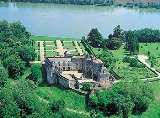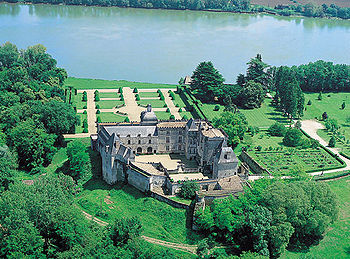
Château de Vayres
Encyclopedia

Dordogne
Dordogne is a départment in south-west France. The départment is located in the region of Aquitaine, between the Loire valley and the High Pyrénées named after the great river Dordogne that runs through it...
River, located in the commune of Vayres
Vayres, Gironde
Vayres is a commune in the Gironde department in Aquitaine in southwestern France.-Population:-Sights:*The Château de Vayres...
, in the Gironde
Gironde
For the Revolutionary party, see Girondists.Gironde is a common name for the Gironde estuary, where the mouths of the Garonne and Dordogne rivers merge, and for a department in the Aquitaine region situated in southwest France.-History:...
Department of France, near the city of Bordeaux
Bordeaux
Bordeaux is a port city on the Garonne River in the Gironde department in southwestern France.The Bordeaux-Arcachon-Libourne metropolitan area, has a population of 1,010,000 and constitutes the sixth-largest urban area in France. It is the capital of the Aquitaine region, as well as the prefecture...
. The château de Vayres was rebuilt during the Renaissance, and again in 1700. It is classified as an official historical landmark of France, and the gardens are listed as among the Notable Gardens of France
Notable gardens of France
The Remarkable Gardens of France is intended to be a list and description, by region, of the over two hundred gardens classified as "Jardins remarquables" by the French Ministry of Culture and the Comité des Parcs et Jardins de France...
by the Committee of Parks and Gardens of the French Ministry of Culture,
History
The castle is located on a point dominating the Dordogne River. Excavations found pottery ovens, indicating that the site had a large population in Gallo-Roman times, and that there was a wooden fort on the site, and later a gallo-roman oppidumOppidum
Oppidum is a Latin word meaning the main settlement in any administrative area of ancient Rome. The word is derived from the earlier Latin ob-pedum, "enclosed space," possibly from the Proto-Indo-European *pedóm-, "occupied space" or "footprint."Julius Caesar described the larger Celtic Iron Age...
, or fortress.
The castle was built in the 11th century to protect the city of Bordeux. It was made of stone and surrounded by a wooden palisade, as attested in a manuscript dated 1092. Nothing remains of the original structure.
In 1288 the chateau and lands were given as a dowry to Amanieu VII d'Albret, who became the seigneur des Vayres. He strengthened the chateau with a new tower, Tour du Moulin. The chateau remained in his family for three hundred years, until the time of King Henry IV.
Beginning in 1326 Bérard d’Albret took the side of England in the struggle for control of the region. He received financial support from King Eward II of England, and turned the castle into a large fortress. From that period, the donjon, the entry and the moats, now dry, still remain.
The château was badly damaged during the Hundred Years War. During the 14th century, its successive owners switched back and forth between the French and English side. The castle was seized in retaliation and given to different nobles, including Gaston de Foix
Gaston de Foix
Gaston de Foix, Duc de Nemours , also known as The Thunderbolt of Italy, was a French military commander noted mostly for his brilliant six-month campaign from 1511 to 1512 during the War of the League of Cambrai....
, and another branch of the d'Albret family. In 1499 it was given by marriage to Cesar Borgia, whose daughter then restored it to the Henri d'Albret. the king of Navarre and the grandfather of the future King of France, Henry IV
Henry IV of France
Henry IV , Henri-Quatre, was King of France from 1589 to 1610 and King of Navarre from 1572 to 1610. He was the first monarch of the Bourbon branch of the Capetian dynasty in France....
, in 1535.
Henry IV inherited the house through his mother, Jeanne d'Albret. He stayed in the castle several times, and then in 1583 he sold it, largely ruined, to Ogier de Gourgue. Ogier de Gourgue was in charge of the treasury of Guyenne, and he commissioned a well-known architect, Louis de Foix, who had built the lighhouse of Cordouan and had worked for the king of Spain, to rebuild the castle in the new style of the French Renaissance
French Renaissance
French Renaissance is a recent term used to describe a cultural and artistic movement in France from the late 15th century to the early 17th century. It is associated with the pan-European Renaissance that many cultural historians believe originated in northern Italy in the fourteenth century...
, with an elegant facade, in the mannerist style of the late Renaissance, facing the Court of Honor.
In the 17th century the Château de Vayres was the scene of battles between the Gourgue family and other nobles the region against the power of Cardinal Mazarin and the young King Louis XIV. The chateau was badly damaged during these battles.
In about 1700 Jacques-Joseph de Gourgue, the bishop of Bazas, undertook the restoration of the chateau in the style of the eighteenth century. He harmonized the structures and created a monumental stairway on the site of the old moats. In the beginning of the 17th century he replaced the drawbridge and the barbacane with the present bridge and portico in the style of Vauban, by which one today enters the chateau. The chateau has not been restored since that time.
The Gourgue family were the owners of the chateau until 1900. In 2001, the chateau was classified as an historical monument of France. The castle itself is still occupied, and has undergone considerable restoration inside.
The Gardens
The original gardens were created in the 17th century, were large and extended along the Dordogne River. They were abandoned and replaced by fields, and then recreated in 1938 as a Garden à la française by the landscape architectLouis-Ferdinand Duprat. A monumental stairway leads from the chateau across the old moat to the French gardens by the river, where there are parterres bordered with hedges of yew
Taxus
Taxus is a genus of yews, small coniferous trees or shrubs in the yew family Taxaceae. They are relatively slow-growing and can be very long-lived, and reach heights of 1-40 m, with trunk diameters of up to 4 m...
, and boxwood
Buxus
Buxus is a genus of about 70 species in the family Buxaceae. Common names include box or boxwood ....
trees clipped into cone shapes. There is also a flower garden of medieval inspiration, and an English-style park, with cedar
Cedar wood
Cedar wood comes from several different trees that grow in different parts of the world, and may have different uses.* California incense-cedar, from Calocedrus decurrens, is the primary type of wood used for making pencils...
, oak
Oak
An oak is a tree or shrub in the genus Quercus , of which about 600 species exist. "Oak" may also appear in the names of species in related genera, notably Lithocarpus...
, linden
Tilia
Tilia is a genus of about 30 species of trees native throughout most of the temperate Northern Hemisphere. The greatest species diversity is found in Asia, and the genus also occurs in Europe and eastern North America, but not western North America...
, hornbeam
Hornbeam
Hornbeams are relatively small hardwood trees in the genus Carpinus . Though some botanists grouped them with the hazels and hop-hornbeams in a segregate family, Corylaceae, modern botanists place the hornbeams in the birch subfamily Coryloideae...
and copper beech trees.

